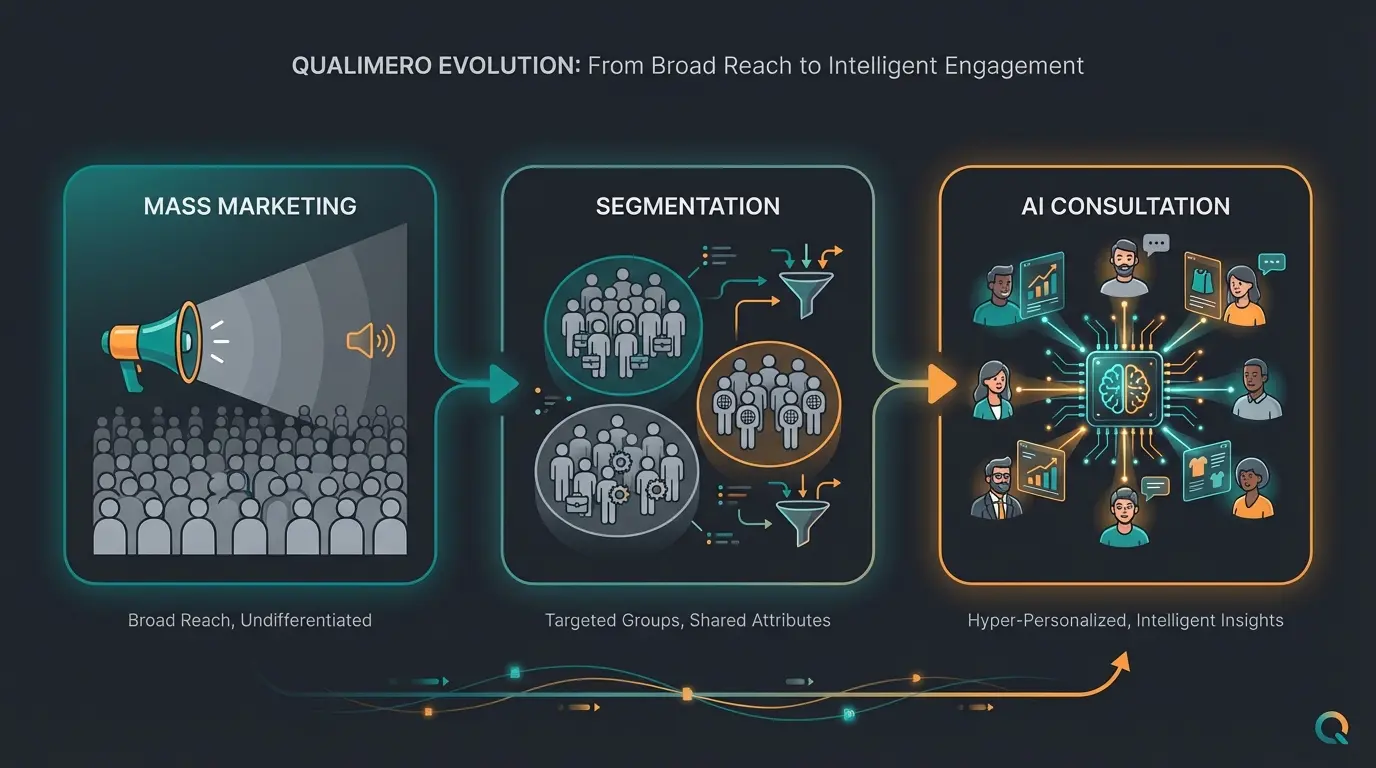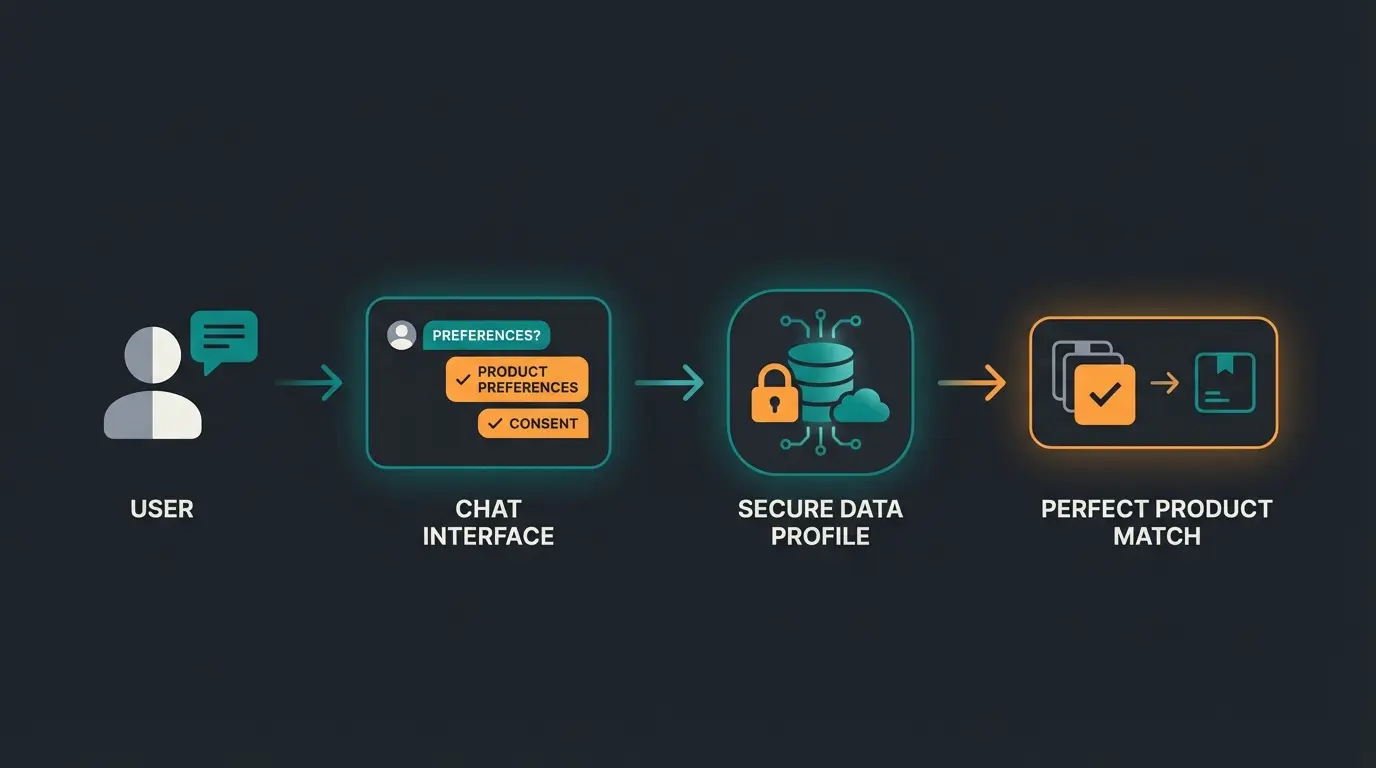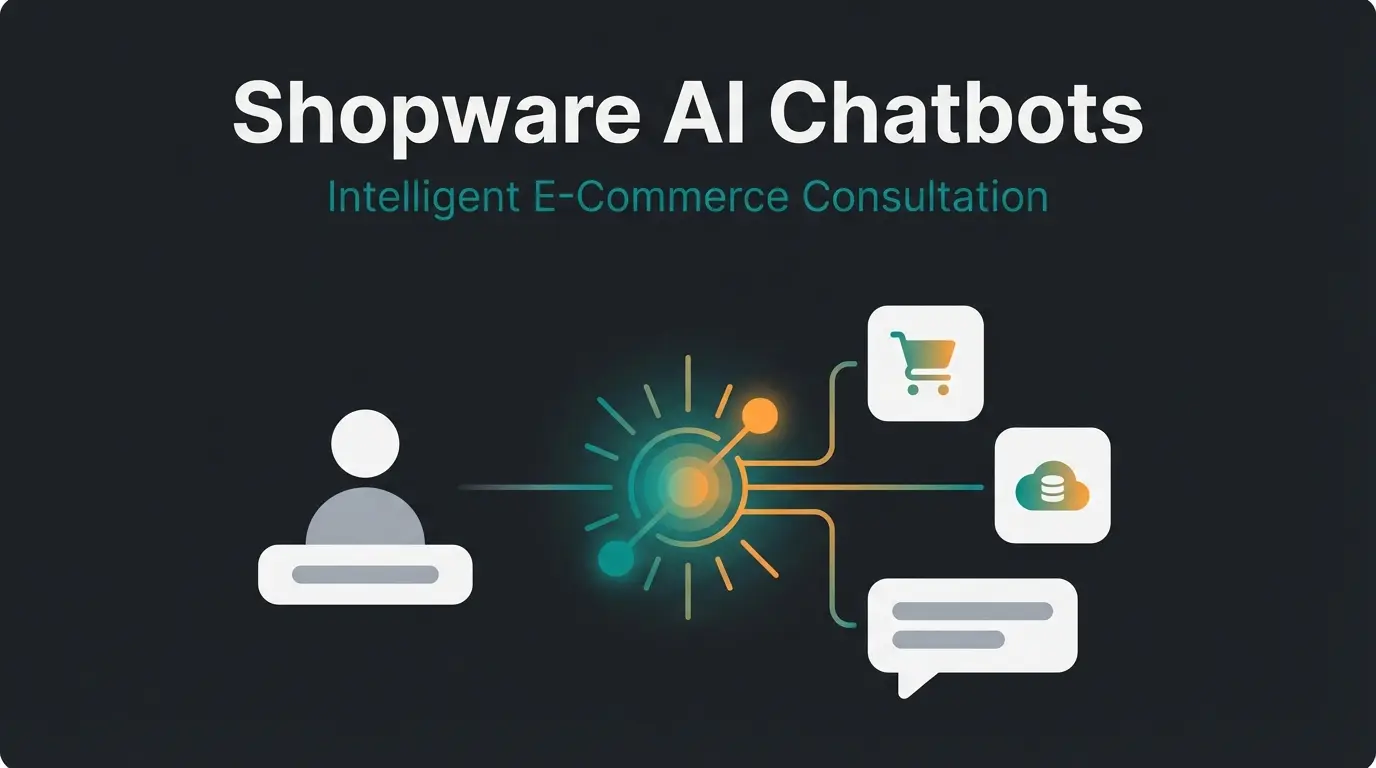Introduction to E-Commerce Personalization
E-Commerce personalization describes the practice of tailoring online shopping experiences individually to each customer. Historically, this meant using data on user behavior, preferences, and purchase history to present tailored product recommendations, content, and offers. However, the definition is evolving. In today's competitive digital retail landscape, simple personalization is no longer enough; it has become a critical factor for standing out from the competition and retaining customers long-term.
Many online shops today suffer from the "self-service warehouse" problem—they offer thousands of products but no staff to help navigate them. True personalization is the solution to this gap.
Current statistics impressively prove the effectiveness of personalization measures in E-Commerce. According to an Analysis by Growth Collective, personalized product recommendations can increase conversion rates by up to 150%. Furthermore, 91% of surveyed consumers stated that they are more likely to shop with brands that provide them with relevant offers and recommendations.
The influence of personalization on business success is significant: Personalized email campaigns achieve on average 29% higher open rates and 41% higher click-through rates than non-personalized mailings. Online shops that consistently implement personalization record revenue increases of on average 19%. At the same time, a more individual customer approach leads to higher customer satisfaction and brand loyalty.
Given these figures, it becomes clear that E-Commerce Personalization is no longer an optional extra, but has become a business-critical core competence for online retailers. In this guide, we will introduce the most important strategies, tools, and best practices to successfully implement personalization in your online shop—moving beyond basic recommendations to true digital consultation.

The 3 Levels of Personalization: Where Do You Stand?
To understand where the market is going, we must distinguish between the different maturity levels of personalization. Most shops are stuck at Level 2, but the highest ROI is found at Level 3.
Basic usage of names in emails (e.g., 'Hi Stefan'). It creates a friendly tone but offers little functional value to the shopping experience.
Passive algorithms like 'Customers who bought X also bought Y.' This relies on tracking cookies and implicit data. It works for simple items but fails for complex decisions.
Active dialogue where an AI acts as a sales consultant. It asks questions ('What is your skin type?') and curates a specific solution based on explicit Zero-Party Data.
Core Benefits of Personalization in Online Retail
The implementation of personalization measures in E-Commerce brings a multitude of advantages that directly impact business success. Among the most important benefits are:
Higher Conversion Rates
By presenting relevant products and offers, the likelihood that visitors turn into buyers increases significantly. According to BigCommerce, personalized product recommendations can increase conversion rates by up to 150%. Personalized landing pages and call-to-actions also contribute to guiding visitors more purposefully through the purchasing process.
Increase in Average Order Value (AOV)
Individually tailored cross-selling and up-selling suggestions encourage customers to add more products to their cart. However, passive suggestions often miss the mark. A personalized product consultation via AI can increase the average order value by 20-30% because it builds the trust required for premium purchases. Dynamic bundle offers based on customer behavior also increase the probability of additional purchases.
Improved Customer Retention and Loyalty
Through a more individual shopping experience, customers feel better understood and valued. This leads to a higher emotional bond with the brand and increased customer loyalty. Personalized loyalty programs and exclusive offers for regular customers further reinforce this effect.
Optimization of Marketing ROI
Targeted, personalized marketing measures achieve significantly higher success rates than mass advertising. The use of AI in sales enables precise customer addressing and campaign optimization in real-time. As a result, marketing budgets can be used more efficiently, and the Return on Investment (ROI) can be significantly increased.
The combination of these advantages leads not only to immediate revenue increases but also creates valuable customer relationships in the long term. Online retailers who consistently implement personalization gain a decisive competitive advantage in the digital trading world.
Stop relying on passive recommendations. Turn visitors into buyers with an active AI sales consultant.
Start Free TrialEffective Personalization Strategies: From Passive to Active
Personalization in E-Commerce is a powerful tool to improve the shopping experience for customers and increase revenue. While traditional strategies focus on passive tracking, the new standard involves active consultation. Here are the most effective strategies:
Strategy 1: AI Product Consultant (The New Standard)
This is the most significant evolution in e-commerce. Instead of guessing what a user wants, an AI Product Consultant engages them in conversation. It distinguishes between a standard FAQ bot (shipping questions) and a Product Consultant (sales questions). Specific AI Personalization understands nuances (e.g., "I need a bike for trails, not roads") and guides the user to the right purchase.
| Feature | Recommendation Engine (Old Way) | AI Product Consultant (New Way) |
|---|---|---|
| Data Source | Implicit (Clicks, Cookies) | Explicit (Zero-Party Data via Dialogue) |
| User Experience | Endless scrolling & filtering | Interactive conversation & curation |
| Best For | Simple items (T-shirts, Books) | Complex products (Electronics, Skincare) |
| Privacy | Relies on tracking (Cookie-heavy) | Privacy-first (User tells AI what they want) |
Strategy 2: Product Recommendations based on History (Foundational)
AI-supported product recommendations remain a core piece of E-Commerce personalization. These systems analyze a customer's browsing behavior and purchase history to suggest relevant products. Amazon is a prime example of the successful use of this technology, with recommendations like "Customers who bought this item also bought..." or "Based on your recent purchases". While passive, this type of personalization helps increase basket size for impulse buys.
Strategy 3: Dynamic Pricing
Individual price adjustments can be an effective means to increase conversions. By analyzing factors such as demand, competitor prices, and customer behavior, online shops can adjust their prices in real-time. This makes it possible to offer each customer the optimal price point that is beneficial for both the retailer and the customer.
Strategy 4: Personalized Email Campaigns
Tailored email content based on customer behavior and preferences can significantly improve open and click rates. Personalized product recommendations, individual offers, and content tailored to the customer make email marketing a powerful channel for customer acquisition and retention. An AI-supported customer service can not only answer inquiries but also generate personalized follow-up emails to further improve the customer experience.
Strategy 5: Individualized Landing Pages
Adapted website experiences can significantly increase the conversion rate. By adjusting content, images, and offers based on customer behavior or the source of traffic, online shops can provide a more relevant and engaging experience. This can be particularly effective when visitors come to the site via targeted advertising campaigns or emails.
Strategy 6: Behavioral Pop-ups
Intelligent pop-up windows that appear based on visitor behavior can be very effective in reducing bounce rates and increasing conversions. For example, a pop-up with a special discount code can be displayed when a visitor intends to leave the cart, or a newsletter sign-up form can appear when a new visitor has been on the site for a longer time.

Data Foundation: The Rise of Zero-Party Data
Effective personalization in E-Commerce is based on a solid data foundation. However, the type of data we use is changing. We are moving away from third-party tracking toward Zero-Party Data—data that the customer intentionally and proactively shares with you.
Key Data Sources
For comprehensive personalization, various data sources are relevant:
- Zero-Party Data (Explicit): Answers to quiz questions, chat dialogues, and direct preferences stated by the user.
- Browsing Behavior (Implicit): Page views, dwell time, click paths.
- Purchase History: Past purchases, cart value, purchase frequency.
- Customer Profile: Demographic data, preferences, interests.
- Device Data: Devices used, operating systems, browsers.
Methods for GDPR-Compliant Data Collection
When collecting data, it is important to respect customer privacy and comply with legal requirements. Here are some best practices:
- Transparency: Clear communication about the type and purpose of data collection.
- Consent: Obtain active approval from users for data collection.
- Data Minimization: Collect and store only necessary data.
- Security: Implementation of robust data protection measures.
Use of AI and Machine Learning for Data Analysis
Artificial Intelligence and Machine Learning play an increasingly important role in the analysis and use of customer data for personalization. AI in sales can also be transferred to personalization in E-Commerce, especially in the analysis of customer data and the creation of personalized offers. These technologies enable:
- Predictive Models: Forecasting future customer behavior.
- Segmentation: Precise classification of customers into relevant groups.
- Real-time Analysis: Immediate adjustment of offers based on current behavior.
- Pattern Recognition: Identification of complex behavioral patterns for targeted actions.
Technologies and Tools for E-Commerce Personalization
Selecting and implementing the right technologies and tools is crucial for successful E-Commerce personalization. Modern platforms offer comprehensive solutions that integrate seamlessly into existing systems.
Leading Personalization Platforms
Various powerful platforms exist on the market covering different aspects of personalization:
Active Product Consultation: Systems like the AI-supported product consultation from Qualimero analyze customer needs in real-time through dialogue and present tailored recommendations. This technology not only increases conversion rates but also the average order value by acting as a digital expert.
Personalized Email Marketing: Tools like Klaviyo or Bronto allow for the creation of highly personalized email campaigns based on customer segments, purchase history, and browsing behavior.
A/B Testing and Optimization: Platforms like Optimizely or VWO offer advanced capabilities to test different personalization strategies and continuously optimize them.
Integration into Common E-Commerce Systems
Most modern personalization tools integrate easily into leading E-Commerce platforms:
- Shopify: Offers an App Store with numerous personalization plugins that can be installed with a few clicks.
- Magento: Enables deep integration of personalization solutions through its open architecture, both via extensions and custom developments.
- WooCommerce: Features a broad ecosystem of plugins covering various personalization aspects.
Best Practices and Success Stories
To illustrate the effectiveness of personalization strategies in E-Commerce, it is worth looking at successful implementations and proven approaches.
Case Studies of Successful Online Shops
Neudorff (The Consultative Approach): The leading provider of garden and plant care products relied on an AI-supported product consultation. By implementing the virtual consultant "Flora," Neudorff achieved outstanding results. Since plant care is complex, a simple filter wasn't enough. The AI acted as an expert gardener:
- Accuracy: 97% in AI-generated product recommendations.
- Speed: Average response time under 5 seconds.
- Efficiency: Cost savings of 99.2% per chat compared to human agents.
Amazon: The E-Commerce giant has successfully relied on personalized product recommendations for years. By analyzing purchasing behavior and browsing history, Amazon generates highly relevant suggestions responsible for up to 35% of its revenue.
Zalando: The online fashion retailer uses AI-supported personalization to suggest suitable outfits to customers. By analyzing style preferences and past purchases, Zalando was able to increase the conversion rate by 29%.
Step-by-Step Guide to Introducing Personalization
For online retailers wishing to implement personalization, the following approach is recommended:
- Create Data Foundation: Collect and structure relevant customer data such as purchase history, browsing behavior, and demographic information.
- Define Goals: Set clear, measurable goals, e.g., increasing the conversion rate by 15% or increasing the average order value by 20%.
- Select Technology: Choose the appropriate personalization platform based on your specific requirements and resources.
- Conduct Test Phase: Start with a limited area of your online shop and conduct A/B tests to verify effectiveness.
- Scale and Optimize: Gradually expand successful strategies and continuously optimize based on the insights gained.
Challenges and Solutions
Personalization in online shops offers enormous opportunities but also brings challenges. Here are the most important hurdles and how online retailers can master them:
Data Protection and GDPR Compliance
The collection and use of personal data are subject to strict legal requirements. Online retailers must ensure that their personalization measures are GDPR-compliant. Solutions include:
- Transparency: Clearly inform customers about data collection and use.
- Consent: Obtain active approval from users for personalized offers.
- Data Minimization: Collect and process only truly necessary data.
- Security: Implement robust encryption and protection measures for customer data.
Balance Between Personalization and Privacy
Customers appreciate personalized experiences but do not want to feel monitored. To find the right balance, online retailers should:
- Control: Give customers the ability to control personalization settings themselves.
- Value: Highlight the concrete benefit of personalization for the customer.
- Boundaries: Do not use overly intrusive or irritating personalization measures.
Technical Challenges
Implementing personalization technologies can be technically demanding. Common challenges and solutions are:
- Integration: Seamlessly integrate personalization tools into existing E-Commerce systems.
- Data Quality: Perform regular data cleaning and validation.
- Performance: Use optimized algorithms and caching strategies for fast loading times.
- Scalability: Use cloud-based solutions to keep up with growing data volumes.
Successfully overcoming these challenges is crucial for effective personalization in online shops. By carefully planning and using appropriate tools, online retailers can overcome these hurdles and fully exploit the benefits of personalization.
Future Trends of E-Commerce Personalization
Personalization in online retail is developing rapidly. The following trends will significantly shape the future of E-Commerce:
Predictive Analytics for Anticipatory Personalization
Artificial Intelligence and Machine Learning make it possible to predict future customer behavior. Online shops can thus:
- Demand Forecasts: Recommend products before the customer actively searches for them.
- Purchase Timing: Determine the optimal moment for offers and discounts.
- Customer Retention: Recognize signs of customer churn early and counteract them.
Voice Commerce and Personalized Voice Assistants
Voice-controlled purchases are gaining importance. Personalized voice assistants will:
- Shopping Lists: Automatically create and adapt to individual preferences.
- Product Recommendations: Submit tailored suggestions during conversation.
- User Profiles: Adapt language and tone to the respective user.
Augmented Reality for Individualized Product Presentations
AR technology makes it possible to place products virtually in the customer's personal environment. Future applications include:
- Virtual Try-On: Test clothing and accessories digitally on one's own body.
- Furniture Visualization: Place furnishings to scale in one's own apartment.
- Personalized Avatars: Create virtual models that match the customer's physique.
These future trends show that personalization in E-Commerce is far from exhausted. Online retailers who focus on these developments early on can gain a decisive competitive advantage and lift their customers' shopping experience to a new level.
Conclusion and Recommendations for Action
Personalization in online shops is no longer an optional extra, but a central strategy for successful E-Commerce. Through individually tailored shopping experiences, retailers can increase customer satisfaction, boost conversions, and build long-term customer relationships.
To fully exploit the advantages of personalization, online retailers should consider the following concrete steps:
- Optimize Data Collection: Implement tools to collect customer data while respecting data protection.
- Use AI Technology: Rely on AI-supported customer service for personalized product recommendations and consultation.
- Conduct A/B Tests: Test different personalization strategies to identify the most effective approaches.
- Pursue Omnichannel Approach: Ensure a consistent personalized experience across all channels.
- Continuous Optimization: Regularly analyze the results of your personalization measures and adjust your strategy accordingly.
By consistently implementing these recommendations, online retailers can use personalization as a competitive advantage and differentiate themselves in a highly competitive market. Investment in personalization technologies and strategies will pay off in the long term through higher customer satisfaction, increased loyalty, and improved business results.
Outlook: The Future of E-Commerce Personalization
Personalization in E-Commerce will continue to develop and become even more precise and comprehensive. Artificial Intelligence and machine learning will play an even greater role, enabling the prediction of customer needs before they arise. AI-supported chatbots and virtual assistants will lift personal consultation in online shops to a new level.
Online retailers who invest in personalization now and continuously develop their strategies will be well-equipped to benefit from these developments and offer their customers exceptional shopping experiences in the future.
Standard recommendations (Level 2) rely on passive data like 'customers who bought X also bought Y.' AI Consultation (Level 3) actively engages the user in dialogue, asking specific questions to understand their needs before suggesting a curated solution.
Yes, especially if you use a consultative approach. Since users actively provide information (Zero-Party Data) during the conversation to get a recommendation, consent is explicit and transparent, making it often more compliant than tracking pixels.
AI consultation works best for complex products where users have questions or face 'choice overload' (e.g., electronics, skincare, bikes, furniture). For simple commodities like toilet paper, standard recurring purchase algorithms are sufficient.
Don't just recommend products—consult your customers. Implement AI-driven personalization today.
Get Your AI Consultant
